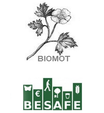The 2016 European Space Agency Living Planet Symposiumwill be held in Prague, Czech Republic from 9-13 May 2016 and is organised with the support of the Ministry of Transport, Ministry of Environment and Ministry of Education, Youth and Sports of the Czech Republic. The event follows previous successful symposia held in Edinburgh (2013), Bergen (2010), Montreux (2007) and Salzburg (2004).
The first announcement has been now released, with a deadline for abstract submission on 16 October 2015.
All received abstracts will be reviewed by a Scientific Committee, notification of acceptance will be provided in early February 2016. Registration to attend the event (free of charge) will be opened in February 2016, after the publication of the preliminary programme.
The objectives of the ESA Living Planet Symposium are to:
- Present the progress and plans for the implementation of ESA Earth Observation strategy and the relevance of ESA's EO Programme to societal challenges, science and economy.
- Provide an international forum to scientists, researchers and users to present and share state of the art results based on ESA's Earth Observation and third-party mission data.
- Review the development of Earth Observation applications.
- Present the Copernicus space component and operational services.
- Report on ESA’s Exploitation Programmes (i.e. Climate Change Initiative, SEOM, DUE, VAE, STSE).
- Introduce the current and future planned Earth Observation missions.
- Outline ESA’s international cooperation in the field of Earth Observation.
- Provide dedicated thematic tutorials and demonstrations.
For more information, please visit: http://lps16.esa.int
The fifth EU BON Policy brief focuses on the need for open data in biodiversity monitoring. The Group on Earth Observation’s Biodiversity Observation Network, of which EU BON is a part, has a vision to better monitor and manage the global biosphere for our common good. This creates research challenges that require use of all appropriate data. Yet, access to data is impaired because, traditionally, few data are released, they are often locked up in traditional scientific literature, or because of concerns over intellectual property rights.
Because of this, EU BON endorses the free and open exchange of data and knowledge in accordance with the "Joint Declaration on Open Science for the 21st Century", especially in regard to scientific information produced in Europe as outlined by the European Commission.
Find out more in the Policy Brief below:
The European Environment Agency (EEA) and the European Space Agency (ESA) signed a Memorandum of Understanding, which sets out common objectives and areas of cooperation in the field of Earth observation and the environment over the coming years, announces a news item published on the EEA website.
Satellite data, such as that provided by the ESA, is a key component of environmental knowledge. The broader view satellite measurements offer of a particular subject at a particular time have improved environmental monitoring, leading to more evidence based policy and, ultimately, better environmental management.
The Memorandum of Understanding sets objectives for the exchange of scientific expertise and technical information between the agencies, providing the basis for mutual access to data and the promotion of joint activities.
Read more in the original news item here.
Global biodiversity loss is intensifying. But it is hard to assess progress towards the Aichi Biodiversity Targets for 2011–20 set by the Convention on Biological Diversity (CBD). Target 5, for instance, aims to halve global deforestation rates by 2020; but reliable indicators for deforestation that can be monitored remotely have not been developed or agreed on. National biodiversity monitoring programmes differ widely, most data sets are inconsistent, and few data are shared openly.
Read more on the topic in the original commentary article.
We are happy to announce that earlier this summer EU BON has been selected to be featured as a successful EU-funded project. The DG Research & Innovation communication team has interviewed our project co-ordinator Christoph Häuser and the resulting article - Combining citizen and satellite biodiversity data - is now a fact!
The news item focuses on EU BON's efforts to bring together biodiversity and Earth observation data, that are accumulated from data sources ranging from the individual citizen scientist, researchers to the most technologically advanced satellites in one EU-wide initiative.
"Information on life on Earth is crucial to addressing global and local challenges, from environmental pressures and societal needs, to ecology and biodiversity research questions," commented Christoph Häuser in his interview.
View the full story on the Horizon 2020 site.
An EU BON workshop took place on 20-23 July in Manaus, Brasil for a targeted group of representatives of the different EU BON WPs or task forces. The workshop was attended by European representatives of EU BON and INPA to discuss potential options to further the integration between European teams and the Brazilian team.
Among topics discussed at the workshop were issues of designing and running biodiversity monitoring observatories (i.e. optimization and guidelines for planning biodiversity monitoring); analyses of biodiversity data to be addressed for assessing changes and patterns; and linkage of (meta-) data to EU BON portal.
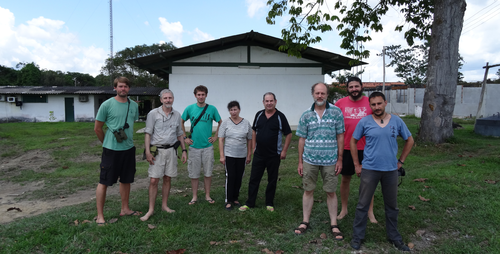

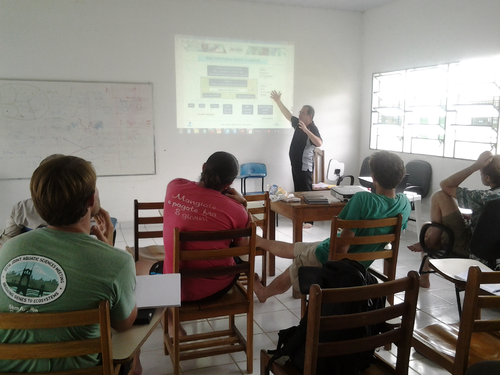
Images from the workshop; Credit: William Magnusson (INPA) & Israel Peer (GlueCAD)
Being hosted in Manaus, this workshop also looked into facilitationg the integration of Brazilian and European expertise, for instance by updating about the progress made by Brazil in starting participatory resource monitoring in Brazilian National parks and the development of databases to integrate this information.
Besides presentation and discussions, INPA organized an excursion to show their log-term biodiversity monitoring field sites (RAPELD) and to explain the rationale and methodology behind their design and organization.


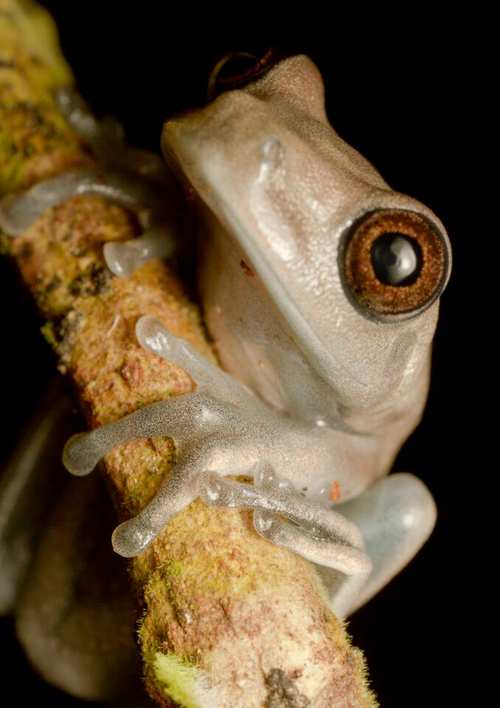
Images from the excursion; Credit: Charlie Marsh
One of our recent associated partners, the EU project GLOBIS-B has published its first paper: "Towards global interoperability for supporting biodiversity research on essential biodiversity variables (EBVs)". You can find the article here.
Abstract:
Essential biodiversity variables (EBVs) have been proposed by the Group on Earth Observations Biodiversity Observation Network (GEO BON) to identify a minimum set of essential measurements that are required for studying, monitoring and reporting biodiversity and ecosystem change. Despite the initial conceptualisation, however, the practical implementation of EBVs remains challenging. There is much discussion about the concept and implementation of EBVs: which variables are meaningful; which data are needed and available; at which spatial, temporal and topical scales can EBVs be calculated; and how sensitive are EBVs to variations in underlying data? To advance scientific progress in implementing EBVs we propose that both scientists and research infrastructure operators need to cooperate globally to serve and process the essential large datasets for calculating EBVs. We introduce GLOBIS-B (GLOBal Infrastructures for Supporting Biodiversity research), a global cooperation funded by the Horizon 2020 research and innovation framework programme of the European Commission. The main aim of GLOBIS-B is to bring together biodiversity scientists, global research infrastructure operators and legal interoperability experts to identify the research needs and infrastructure services underpinning the concept of EBVs. The project will facilitate the multi-lateral cooperation of biodiversity research infrastructures worldwide and identify the required primary data, analysis tools, methodologies and legal and technical bottlenecks to develop an agenda for research and infrastructure development to compute EBVs. This requires development of standards, protocols and workflows that are ‘self-documenting’ and openly shared to allow the discovery and analysis of data across large spatial extents and different temporal resolutions. The interoperability of existing biodiversity research infrastructures will be crucial for integrating the necessary biodiversity data to calculate EBVs, and to advance our ability to assess progress towards the Aichi targets for 2020 of the Convention on Biological Diversity (CBD).
Original Source:
W. Daniel Kissling et. al. (2015) Towards global interoperability for supporting biodiversity research on essential biodiversity variables (EBVs). Biodiversity. DOI: 10.1080/14888386.2015.1068709
It has been recognized that issues regarding the sustainability and interoperability of data collected by citizens hinder the re-usability and integration of these data across borders. The European Commission’s Joint Research Centre (JRC), is following up on these findings with a detailed study of interoperability arrangements, hosting and data management practices of Citizen Science projects. These activities include a survey designed to capture the state of play with regard to data management practices on the local, national and continental scales. The questions are especially inspired by the recently proposed data management principles of the Group on Earth Observations and those of the Belmont Forum.
Beyond the pure stocktaking and awareness raising, the results should establish a base line for prioritizing follow-up activities and measuring progress. The results will also inform the discussion on the potential roles of the European Commission – and especially the JRC – in Citizen Science.
After discussions with members of the European Citizen Science Association (ECSA) and the international Citizen Science Association (CSA), it was decided to open the scope of the questionnaire to the international community, so that non-EU and globally acting organizations could also benefit from the outcomes.
The survey will be open until 31 August 2015, and the results of the subsequent analysis will be available by the end of September. We invite all those involved in Citizen Science projects to take the survey in order to provide us with invaluable information and insight into Citizen Science projects and best practice.
Take the Survey! >> https://ec.europa.eu/eusurvey/runner/CSDataManagement
The report ‘EU 2010 biodiversity baseline - adapted to the MAES typology (2015)’ presents a revised overview of the EEA's EU 2010 biodiversity baseline report.
The revision is necessary because the typology of ecosystems used in the 2010 report has since been altered by a working group of biodiversity experts. The revised report provides recalculated information on the state and trends of the different biodiversity and ecosystem components, based on the new typology of ecosystems.
Find the report here.
A new EU BON derived open access paper looking into Earth Observations (EO) and the Aichi Targets was recently published in the journal Remote Sensing in Ecology and Conservation.
The paper reviews the ABTs and EBVs against direct and indirect, operational and emerging, EO data products. The review was conducted by consulting expert opinion and categorically rating the Targets based on the adequacy of currently available EO technology to build indicators per target. The potential RS-EBVs were also matched with their respective EO data products.
To summarize this information a monitoring framework is proposed where RS-EBVs are used to harmonize observations prior to the indicator stage. Potential obstacles to implementing this framework and challenges to its adoption by the wider science and policy community are discussed. Finally, upcoming satellite missions which could offer potential for assessing global biodiversity status and trends beyond the 2020 timeframe of the CBD's current Strategic Plan for Biodiversity are discussed.
Original Source:
O'Connor B. et. al. (2015) Earth observation as a tool for tracking progress towards the Aichi Biodiversity Targets. Remote Sensing in Ecology and Conservation. DOI: 10.1002/rse2.4
The Department of Conservation Biology at the Helmholtz Centre for Environmental Research (UFZ) is offering a full-time position for a Population Biologist / Conservation Biologist (Postdoc) focussing on assessing past and future trends in species under land use and climate change and improving the design of monitoring schemes. The position will be part of EU BON.
The Helmholtz Centre for Environmental Research (UFZ) with its 1,100 employees has gained an excellent reputation as an international competence centre for environmental sciences. We are part of the largest scientific organisation in Germany, the Helmholtz association. Our mission: Our research seeks to find a balance between social development and the long-term protection of our natural resources.
More information on the oficial job offer page: http://bit.ly/1MexC6Q
The 2016 GEO BON Open Science Conference: "Biodiversity and ecosystem Services Monitoring for the 2020 Targets and beyond. Building on observations for user needs" will take place from 4 to 9 July 2016 in Leipzig, Germany.
Biodiversity Science is facing enormous challenges as the pressures upon the earth’s biotic systems are rapidly intensifying and we are unlikely to reach the CBD 2020 Aichi Targets. But how far or close are we to reach the targets? The GEO BON Open Science Conference on "Biodiversity and Ecosystem Services Monitoring for the 2020 Targets and beyond" will assess this question. The conference is open to the wide scientific public and is sponsored and co-organized by iDiv, UFZ, SASCAL (others to come).
For more information please visit: http://conf2016.geobon.org
Future Directions for Scientific Advice in Europe was published in April 2015 and updated in June 2015 to take account of developments in the European Commission, focuses on scientific advice in Europe.
A free digital copy of and more information on Future Directions for Scientific Advice in Europe can be found here.
A new EU BON acknowledging special issue "Earth Observation for Ecosystems Monitoring in Space and Time: A Special Issue in Remote Sensing" published in the open access journal Remote Sensing provides a collection of important researchers in the field, as well as the most challenging aspects of the application of remote sensing to study ecosystems.
http://www.mdpi.com/journal/remotesensing/special_issues/ecosystemsmonitoring
The joint BESAFE/BIOMOT Conference "Motivations and arguments to act for biodiversity" took place on 10 & 11 June 2015 in Brussels, Les Ateliers des Tanneurs. The main objective of the conference was to present alternative ways to inspire innovative policy making to act for nature.
Based on four years of large-scale research by the two European projects, the conference aimed to define what could really work to motivate society to act for nature. The conference involved a wide audience in high-level keynotes, science-policy interface sessions, stakeholder meetings and panels.
The joint event was also a platform for the BESAFE project Final Conference where the beta version of the BESAFE tool was presented and tested. The tool is planned as a user-friendly application where stakeholders can browse project results and background information to help them to help them to improve biodiversity argumentation.
The 9th GEO European Projects Workshop took place on 15 and 16 June 2015, in Copenhagen, Denmark. A special session dedicated to biodiversity and ecosystems was held as a part of the meeting, where EU BON and other topic relevant projects were presented.
The session was started by Gary Geller with an introduction and overview. Particularly the importance of the long-term sustainability of the projects and the linkages to the overall aims of GEO were stressed, as well as the opportunity of the session to find further synergies among the GEO-related projects.
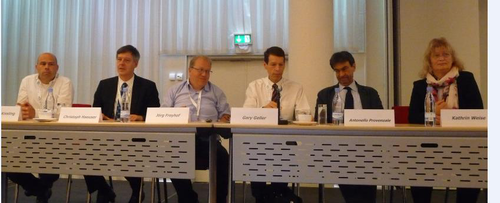
Participants at the biodiversity and ecosystems sessions during the 9th GEO European Projects Workshop; Credit: Florian Wetzel
EU BON was presented at the meeting by the project coordinator Christoph Häuser, who outlined the core elements for an integrated biodiversity information system. There is the challenge to provide a sound framework to overcome the fragmentation of available biodiversity information to obtain better information for political decision making. EU BON with its 31 partners tackles this challenge and its main objective is to serve as a European contribution to GEO BON.
Other projects presented during the session were EU H2020 projects ECOPOTENTIAL and GLOBIS‑B, both already in the list of associated partners of EU BON. The third H2020 project presented here was SWOS, a Satellite-based Wetland Observation Service.
One of the major outcomes of the session was the agreement that further follow-ups of the discussions are needed and that the projects should have further exchange among each other.
The European Environmental Agency (EEA) has published its Annual Report describing the work carried out by the EEA in 2014. The EEA annual report includes the EMAS environmental statement 2014.
Download the report here.
A free GEO/Ramsar webinar titled "Wetlands, Biodiversity and the Role of Earth Observations" is taking place today - 18 June 2015. The webinar is designed for anyone with an interest in or passion for biodiversity and wetlands - students, scientists, experts, or anyone with a general interest in one or more of these topics – who wants to learn from these vast global communities.
This is the first of a series of planned webinars on the role of Earth observations in monitoring and sustaining biodiversity and wetlands. The webinars will be hosted by the GEO Biodiversity Observation Network (GEO BON) and GEO Water Community, together with the Ramsar Secretariat and will include leading experts from the global communities highly engaged in biodiversity, wetlands and Earth observations.
To watch the event and register follow the link: https://blbgroup.leadpages.net/webinar-wetlands/
Our family of Associated Partners has grown with three new members that joined us this month. EU BON has signed MoUs with the GLOBal Infrastructures for Supporting Biodiversity research (GLOBIS-B), the Institute of Geosciences and Earth Resources of the National Research Council of Italy (IGG-CNR) and ECOPOTENTIAL: Improving Future Ecosystem Benefits through Earth Observations, The hand over took place during the 9th GEO European Projects' Workshop in Copenhagen (15 – 16 June 2015).

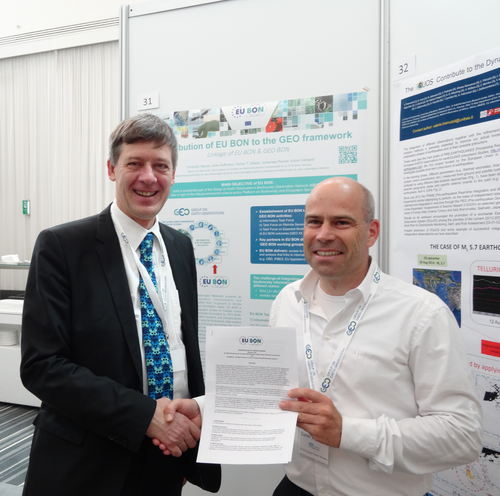
Left: EU BON coordinator Christoph Hauser and Anke Hoffmann handing over the MoUs to our partners from IGG-CNR and ECOPOTENIAL Antonello Provenzale, Carl Beierkuhnlein and Palma Blonda; Right: Handing over the MoU to Daniel Kissling - scientfic coordinator of GLOBIS-B; Credits: Anke Hoffmann
The GLOBIS-B project is a new H2020 project aiming to bring together biodiversity scientists with research infrastructure operators and legal interoperability experts to address the research needs and infrastructure services required to calculate Essential Biodiversity Variables (EBV) at a global scale.
ECOPOTENTIAL makes significant progress beyond the state-of-the-art and creates a unified framework for ecosystem studies and management of protected areas (PA). ECOPOTENTIAL focuses on internationally recognized PAs in Europe and beyond in a wide range of biogeographic regions, and it includes UNESCO, Natura2000 and LTER sites and Large Marine Ecosystems. Best use of Earth Observation (EO) and monitoring data is enabled by new EO open-access ecosystem data services (ECOPERNICUS).
IGG-CNR conducts studies based on mineralogy, petrology, geochemistry, geodynamics and geophysics, aimed at understanding the processes occurring both in the interior and at the surface of the Earth, and providing the fundamental knowledge for the applications (technological use of geomaterials, mitigation of the natural risks and correct management of the Earth resources for a sustainable development).
The 9th GEO European Projects Workshop is now taking place on 15 and 16 June 2015 in Copenhagen, co-organised by the Danish Meteorological Institute, the European Commission and the European Environment Agency.
While registration is now closed, due to demand the event will be recorded and streamed live on http://stream.dvc.dk/9thgeo/ for those who are interested to follow.
The objective of the GEO European Projects Workshop is to bring together European players interested in and actively contributing to the Global Earth Observations System of Systems (GEOSS). The aim is to enable participants to present their work and discuss how Europe can contribute to this international effort. Its timing has been set to maximise early insight and awareness of the new Implementation plan for the next decade of GEO as well as input to and awareness of Horizon 2020 work programme for 2016 and 2017.
Building on the experience from previous GEO European Projects Workshops, it is intended to continue working towards greater involvement of the European private sector, especially SMEs, in GEO. The workshop will also focus on user engagement, and the priorities for future flagship initiatives, foreseen to be strengthened in the next phase of GEO, in order to fulfil GEO's ambition to provide information for decision making.
More information available on the official event page: http://geo.pbe.eionet.europa.eu/




 RSS news
RSS news

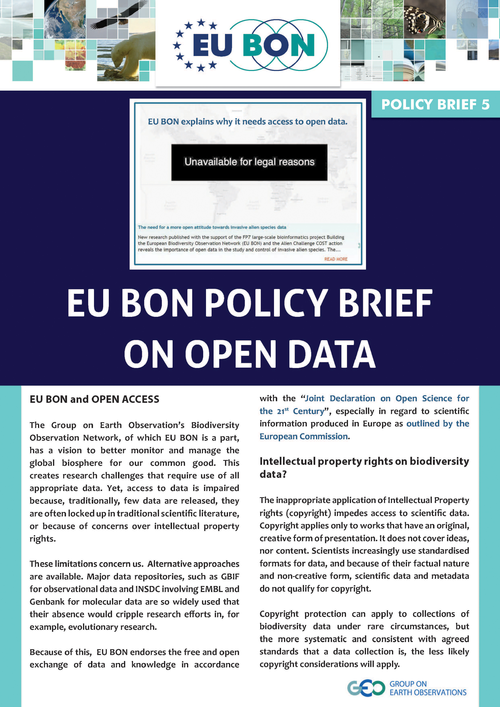




 Survey Flyer
Survey Flyer


